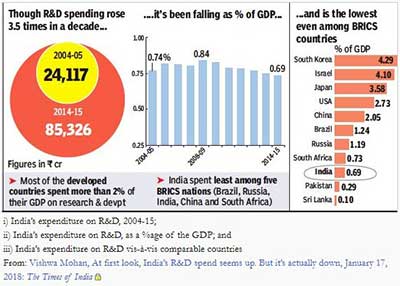Relevance: GS-2: Government Policies and Interventions for Development in various sectors and Issues arising out of their Design and Implementation.
Relevance: GS-3: Government Budgeting.
Key Phrases: Gross domestic expenditure on R&D (GERD), Gross domestic product (GDP), Global Innovation Index, Sunrise opportunities, National Education policy) 2020, National Research Foundation (NRF), Brain-drain, Human Capital.
Background:
- The Economic Survey 2020-21 released last year took note of the fact that India made it to the coveted list of top 50 innovative countries for the first time in 2020, ranking 48th among 131 countries in the Global Innovation Index (GII). It further pointed out that there is a need for more push towards innovation and the need for the business sector’s contribution to gross domestic expenditure on R&D.
- But, a quick analysis of the allocations to various R&D organisations in the recently presented 2022-23 budget shows continued stagnation. This does not augur well for the future.
Status of R&D in India:
- According to UNESCO’s stats, the global expenditure on
research and development (R&D) has crossed $1.7 trillion. Where does
India stand in terms of spending on R&D? The most used indicator to
measure country-wise investments in R&D is the gross domestic expenditure
on R&D (GERD) as the percentage of gross domestic product (GDP).
- A comparison of the R&D spending of some of the countries representing different regions of the world and India in terms of GERD as a percentage of GDP (see graph) shows India to be a low spender (only 0.66 percent of the GDP) in comparison to the developed countries and emerging economic powers of East Asia.
- The percentage expenditure for the last couple of years is showing a downward trend.

Budget 2022-23 - Focus on R&D:
The finance minister’s budget speech for 2022-23 contains two references to R&D-related issues.
- One, defence R&D will be opened for industry, start-ups, and academia with 25 percent of the defence budget earmarked for such activities.
- The other, identification of sunrise opportunities in areas like
artificial intelligence, geospatial systems and drones, semiconductors,
space, genomics and pharmaceuticals, green energy, and clean mobility
systems.
- For R&D in these sunrise opportunities, in addition to efforts of collaboration among academia, industry and public institutions, government contribution will be provided.
- However, the budget has no extra provisions for R&D in the flagged sunrise opportunities.
The pre-budget Economic Survey for the financial year 2021-22 does not even mention R&D in contrast to the 2020-21 Survey that flagged the issue of very low investments in R&D.
Issues of R&D sector:
- Low expenditure by state: India spends only 0.7 percent of its GDP which is lowest even among the BRICS nations.

- Lacking private sector participation: In most of the developed
capitalist countries, defence-related R&D is undertaken by the private
sector. In India, this expenditure is mostly borne by public funding. The
private sector spending is only 37 percent in India.
- The ratio of private to public spending in R&D was 19:81 in 2001-02, it improved to 35:65 in 2011-12 but continues to stagnate since then.
- Inadequate R&D work at university level: Between 2011-12 and
2017-18, the number of universities/institutions increased from 752 to 1,016
and doctoral degrees awarded yearly from 10,011 to 24,474. The increase in
the number of universities/institutions and the number of doctoral students
is not commensurate with the meagre increase in funding leading to
deterioration in the standards of R&D work at the doctoral level.
- The situation is particularly grim in the universities that depend on the DST, DBT, ICMR and CSIR under their extramural support system.
Suggestions and Measures Required:
- More spending by state: Economic Survey 2020-21 suggested that the country needs to increase its GERD from around 0.7 percent to over 2 percent of its GDP as is the situation with the Western and East Asian economies.
- Increasing private sector spending: The survey suggested that the private sector needs to raise its share of spending from 37 percent to 68 percent of the total spending on R&D like the other high spenders.
- NEP (National Education policy) 2020 suggested the establishment
of a National Research Foundation (NRF) to fund competitive,
peer-reviewed grant proposals from the universities, colleges, and
institutions of higher learning.
- Budget 2021 proposed an allocation of Rs 50,000 crore over the next five years. However, in the actual budget, no such provision was made.
- Cover the current deficits in R&D: Cater to the present and
future needs by committing to raise the spending on R&D to 1 percent of the
GDP.
- The amount of Rs 50,000 crore committed in the 2020-21 budget to establish NRF could be immediately used to plug the deficits in the extramural grants provided to the autonomous universities and Institutions by CSIR, DST, SERB, DBT, ICMR, ICAR, and other agencies.
- Upgrading SERB: The SERB (Science Engineering Research Board), that’s already performing the job of funding projects on a competitive basis, can be upgraded to play the role envisaged for NRF.
- Eliminating information asymmetry: A virtual platform that will hold all the information on the projects granted with public funding could be developed for better information sharing.
- Joint R&D projects: With increased allocations, joint R&D
projects between public institutions and start-ups/industries can also be
supported. Funding of projects could become comprehensive and cover their
entire expenditure. Almost all the developed countries follow this practice.
- Joint projects with some of the leading laboratories worldwide could also be funded by the enhanced funding allocation. India
- Focus on Human Capital: To make India self-reliant, the country
requires the upgradation of human resources in R&D. Currently, there is a
lack of adequate expertise in many emerging areas.
- In the next five to six years, around 5,000 students/scientists need to be trained at the doctoral and post-doctoral level in the best laboratories abroad in areas of R&D where India needs to do better for national prosperity and areas of strategic importance.
- Establishing good relations with advanced countries: If India has good relations with the economically developed democratic world, then it would help in collaborating on research on technology like India has with USA and UK.
- Increasing remuneration for young scientists: post-doctoral work
in India should be encouraged by providing better remuneration to the young
scientists.
- It would help in curbing Brain-drain problems as well.
Conclusion:
- To move from stagnation in R&D to a more dynamic ecosystem would require action on many fronts. Science and technology departments will have to work out how to fast-track decision-making, information sharing, and allow investigators more flexibility in utilising the funds. It will be useful if the science academies of India become more communicative, both with the public and government, on issues related to R&D.
- “Science in the end will help man. She will make the necessities of life easily accessible to every man, so that humanity will be freed from the tyranny of matter which now humiliates her” – Rabindranath Tagore
Sources: Indian Express
Mains Question:
Q. India must focus on improving its performance on institutions and private sector participation to boost the R & D sector. Analyse. [250 words].







